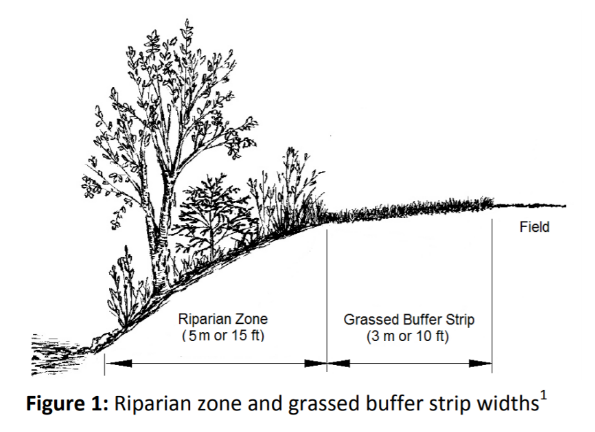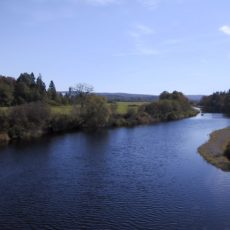Whether you are a livestock or crop producer, you need water. Watercourses are common on many farm properties and farms are shaped by where water is located. Traditionally, barns and farm yards were situated adjacent to watercourses so they had a reliable source of water for the farm. Over time, as new sources of water were developed (e.g., wells) and as our understanding of the impact that agricultural activities can have on aquatic ecosystems has increased, we have shifted our focus towards protecting watercourses from run-off and other contamination risks.
One of the best things we can do to protect watercourses is to ensure that we maintain an area of natural vegetation along the waterway. A riparian area, or riparian zone, is the term given to describe the permanently vegetated land located at the edge of a field along a river, stream, brook or pond. Although riparian areas make up only a small fraction of the land, they are among the most productive and valuable areas on the farm landscape.
Maintaining riparian zones helps to limit the negative impacts of soil erosion, nutrient loss and pesticide applications on water quality. Riparian zone vegetation usually contains a combination of plants of mixed height, growth habit and density, e.g., trees, shrubs, grasses, sedges and ferns. Riparian zones can look quite different depending on their location and a diversity of plants within the riparian area is beneficial for a variety of ecological functions including:
- Naturally maintaining and reinforcing stream banks
- Shading the watercourse to keep the water cooler (improving water quality and fish habitat)
- Trapping sediments and filtering nutrients from precipitation run-off
- Maintaining and enhancing biodiversity
- Sequestering carbon

Riparian areas should be composed of at least 5 m (15 ft) of mixed vegetation. Wider is better as it provides a greater opportunity to maintain water quality and will provide more habitat. Riparian zones are established by discontinuing cropping to the edge of a watercourse, fencing livestock and allowing natural vegetation to re-establish. If the area is severely degraded, planting native trees and shrubs can help stabilize the bank and allow natural vegetation to establish more quickly. It will mean a slight decrease in cropping acreage, but will be worth the investment as the landscape will be more resilient to heavy rainfall events by buffering run-off and reducing erosion. For row crop production, it is also recommended to establish an additional 3 m (10 ft) grassed buffer strip between the riparian zone and the field as there is a greater risk of soil erosion. Buffers provide long-term conservation benefits but also provide practical benefits to farmers by straightening irregular fields and avoiding the need to plant end-rows where crop yields are often lower.
To help with costs associated with establishing riparian areas, funding is available through the Nova Scotia Department of Agriculture’s Soil and Water Sustainability Program. Producers can receive up to 60% (to max. of $10,000) of eligible expenses such as the purchase of trees, shrubs, and riparian fencing for restricting livestock access to watercourses. Funding is also available for remote livestock watering systems to provide an alternate water source for livestock.
For more information related to riparian areas, there is the Beneficial Management Practices for Riparian Zones in Atlantic Canada publication available and a new AEP factsheet, Life on the Edge – Riparian Zone Establishment. For these documents and other factsheets, check out the resources section of our EFP website: https://nsefp.ca/publications-fact-sheets/.




